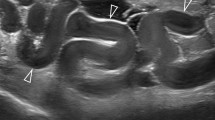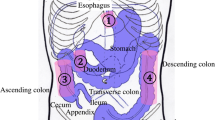Abstract
Viscera slide is the normal, longitudinal movement of the intraabdominal viscera caused by respiratory excursions of the diaphragm. By detecting areas of restricted viscera slide, ultrasonic imaging was used to identify anterior abdominal wall adhesions prior to laparotomy or laparoscopy. Transcutaneous ultrasound examination was performed on 110 patients. A prediction of adhesions was made for each patient and then compared to the findings during subsequent laparotomy or laparoscopy. Only patients with previous abdominal surgery or history of peritonitis demonstrated adhesions. Sensitivity and specificity of viscera slide ultrasound in predicting adhesions were 90% and 92%. Nine out of 10 false results involved misinterpretation of ultrasound images of the lower one-third of the abdomen. Ultrasonic imaging of viscera slide is highly accurate in detecting abdominal wall adhesions. This technique is most useful in guiding the insertion of trocar in laparoscopic surgery, and as a noninvasive method in studying the formation of adhesions.
Similar content being viewed by others
References
Cuschieri A (1993) Personal communication
Gai H, Thiele H (1992) Sonographische selektionskriterien für die laparoskopische cholecystektomie. Chirurg 63: 426–431
Hart R, Classen M (1990) Complications of diagnostic gastrointestinal endoscopy. Endoscopy 22: 229–233
Kodama I, Loiacono LA, Sigel B, Machi J, Golub RM, Parsons RE, Justin J, Zaren HA, Sachdeva AK (1992) Ultrasonic detection of viscera slide as an indicator of abdominal wall adhesions. J Clin Ultrasound 20: 375–380
Linder J, Elias EG (1992) Complications of operative and endoscopic gastrostomies. Md Med J 41: 219–221
Peterson HB, Hulka JF, Phillips JM (1990) American Association of Gynecologic Laparoscopists 1988 membership survey on operative laparoscopy, Zentralbl Gynakol 112: 1497–1500
Ponsky JL (1991) Complications of laparoscopic cholecystectomy. Am J Surg 161: 393–395
Reddick EJ, Olsen DO (1990) Outpatient laparoscopic laser cholecystectomy. Am J Surg 160: 485–487
Reddick EJ, Olsen DO, Spaw A, Baird D, Asburn H, O'Reilly M, Fisher K, Saye W (1991) Safe performance of difficult laparoscopic cholecystectomies. Am J Surg 161: 377–381
Sigel B, Golub RM, Loiacono LA, Parsons RE, Kodama I, Machi J, Justin J, Sachdeva A, Zaren HA (1990) Technique of ultrasonic detection and mapping of abdominal wall adhesions. Surg Endosc 5: 161–165
The Southern Surgeons Club (1991) A prospective analysis of 1518 laparoscopic cholecystectomies. N Engl J Med 324: 1073–1078
Wolfe BM, Gardiner BN, Leary BF, Frey CF (1991) Endoscopic cholecystectomy: an analysis of complications. Arch Surg 126: 1192–1198
Author information
Authors and Affiliations
Rights and permissions
About this article
Cite this article
Kolecki, R.V., Golub, R.M., Sigel, B. et al. Accuracy of viscera slide detection of abdominal wall adhesions by ultrasound. Surg Endosc 8, 871–874 (1994). https://doi.org/10.1007/BF00843457
Received:
Accepted:
Issue Date:
DOI: https://doi.org/10.1007/BF00843457




